Carrier Fire and Security Americas ATR20105-1 Hand Held Reader User Manual Security Client Symbian LZT 10 102 R1B indd
UTC Fire & Security Americas Corporation, Inc Hand Held Reader Security Client Symbian LZT 10 102 R1B indd
users manual
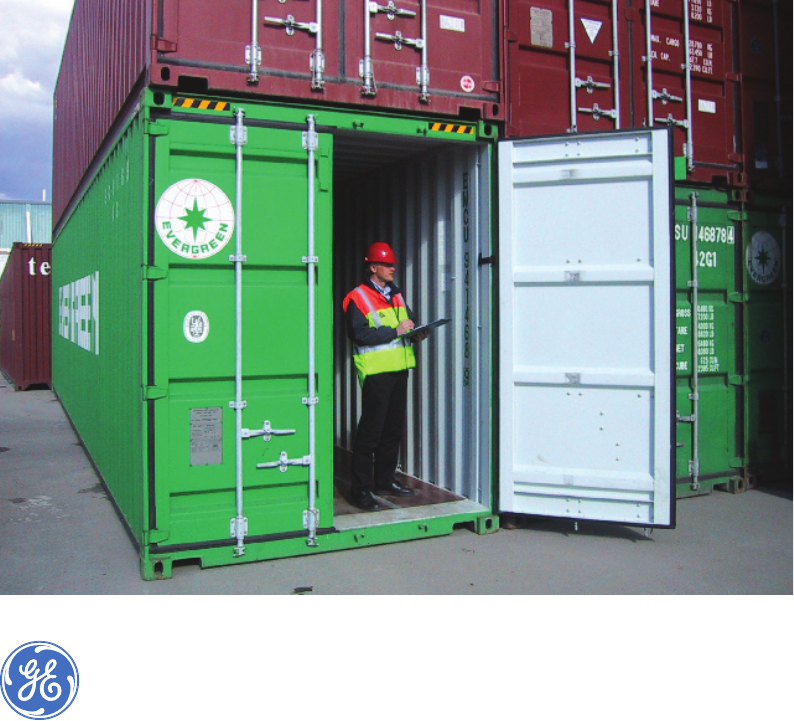
GE
Security
CommerceGuard™
Security Client ― Symbian
Reference Guide
imagination at work
LZT 10 102 R1B

2
Contents
4 Introductio
n
4 System Overvie
w
5 Installing PC Suite Softwar
e
6 Upgrading
Security Client ― Symbian
Softw
ar
e
7 Logging into the Softwar
e
8 Plug In
Reader and Verify Communicatio
n
10 View
ing Status of CSD
s
11 Downloading/Purchasing Encrypted Key
s
12 Installing the CSD on the Containe
r
13 Arming the CS
D
15 Activating Consumed Key
s
16 U
ploading
CSD Statu
s
17 Checking the CSD
Data Lo
g
18 Disarming the CS
D
19 Removing the CS
D

3
CommerceGuard™ Security Client for Symbian
Legal
Licensed by GE from All Set Marine Security AB.
Copyright
© 2005 GE Security. All rights reserved. GE is a registered trademark of the General
Electric Company. GE Security is a trademark of the General Electric Company.
CommerceGuard is a trademark of GE Security or its subsidiaries.
Contacting Us
For general questions and support, send an email to:
support@allset.se
support@allset.se
For specifi c questions, call or email one of the following representative:
USA Charles Albright +1 760 8323161
charles.albright@ge.com
charles.albright@ge.com
Europe Pontus Törnlund +46 708 370423
pto@allset.se
pto@allset.se
Asia Arthur Lu +866 7 7223416
alu@allset.se
FCC Information
This device complies with Part 15 of the FCC Rules. Operation is subject to the following
two conditions: (1) This device may not cause harmful interference, and (2) This device
must accept any interference received, including interference that may cause undesired
operation.
Note: The manufacturer is not responsible for any radio or TV interference caused by
unauthorized modifi cations to this equipment. Such modifi cations could void the user’s
authority to operate the equipment.
•
•
•
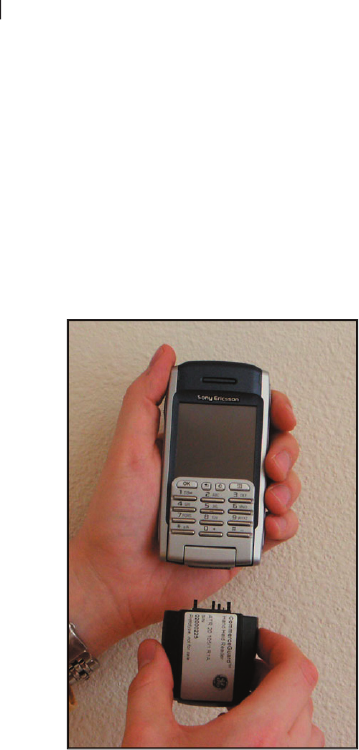
4
Introduction
The Security Client ― Symbian software is
installed on a Sony Ericsson P800, P900,
or P910 cellular phone. When used with a
CommerceGuard™ Portable Reader Unit,
it can confi gure, manage, and inspect
Container Security Devices (CSDs).
System Overview
The Security Client for Windows software
is used to manage Container Security
Devices (CSDs). A CSD is placed on the right
door frame inside a shipping container, the
container is stuffed and the container door
closed. Using the Security Client software
either with a handheld reader or on a
computer attached to a fi xed reader, the
CSD is armed and the serial number of the
container and a load ID are programmed into
the CSD. The container is then shipped out.
When the container arrives at it’s destination
the Security Client software shows if the
container has been tampered with. The CSD
can then be disarmed and the container door
opened.
The handheld reader unit is plugged into the
cell phone. It is then capable of communicating
wirelessly with the CSDs.
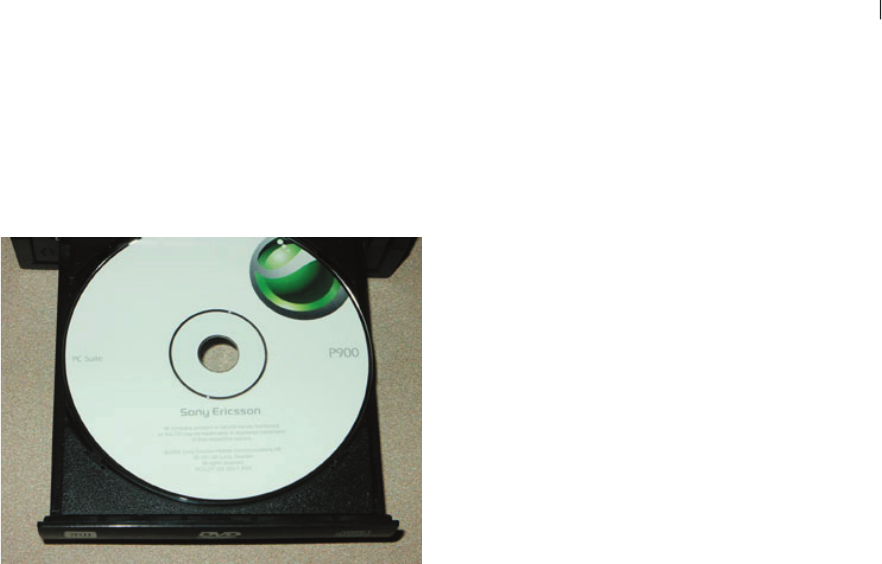
5
CommerceGuard™ Security Client for Symbian
Installing PC Suite Software
You will need to dock your phone to a PC for
a number of reasons. In order to dock your
phone, fi rst install the Sony Ericsson software
that comes with the reader.
Reasons for docking your handheld reader:
You may have to download keys (in
order to arm containers) over the
Internet, if there is no GPRS coverage
over the public wireless network.
You may need to update the
CommerceGuard software.
You may want to upload CSD logs
to the PC (you are able to check
CSD logs and save them to phone
memory).
When inserting the CD in the PC, a start
menu is automatically shown.
•
•
•
1.
Select language and then start the PC Suite
Setup.
Follow the instructions in the installation
wizard.
If the start menu is not automatically
shown, use the ‘Run’ command in the
‘Windows Start’ menu to start ‘Start.exe’
from your CD drive.
By default the ‘PC Suite’ is accessed from:
Start menu >Programs > Sony Ericsson >
P910 (or P800 or P900).
The Setup application can also be used
later to add or delete components.
2.
3.
4.
5.
6.
7.
The PC Suite software can be installed on
Windows ME, 2000 and XP.

6
Upgrading Security Client ―
Symbian Software
Remove the reader module and dock the
phone in the cradle:
Verify communication between the PC and
the phone (the phone icon should appear
in the task bar in the lower right corner on
your PC screen).
Double-click the latest ‘CG Security
Client‘ fi le located on your computer to
automatically start the installation. You
may have received the update via e-mail or
some other media.
When the ‘Install Software’ dialog opens,
click Yes.
When the ‘Installation security warning’
dialog opens, click ‘Install anyway’.
When the ‘About to install application’
dialog box opens, click Next.
When the ‘Select language‘ dialog box
opens, select English (U.K.) from the list, and
click Next.
When the ‘Install File’ dialog box opens,
click Finish.
Upgrade is complete.
1.
2.
3.
4.
5.
6.
7.
8.
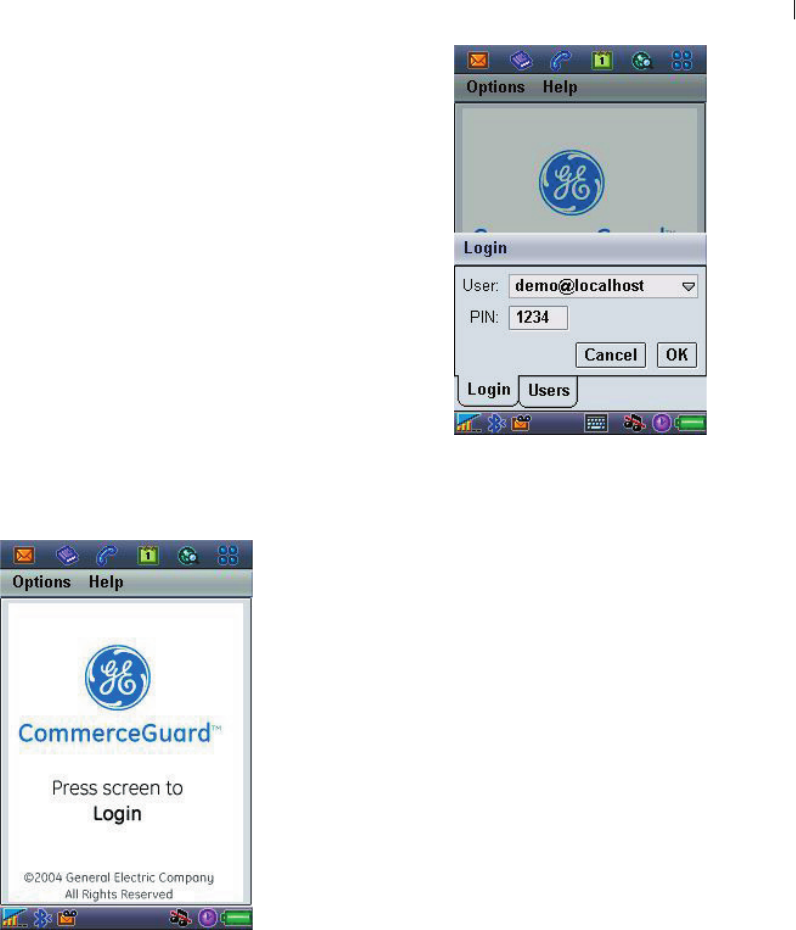
7
CommerceGuard™ Security Client for Symbian
Logging into the Software
When a user logs into the Security Client
software, their User name and PIN are
validated at the CommerceGuard network. The
fi rst time a user logs in to the Security Client
software an Internet connection is required
to authorize the user and PIN. The Internet
connection is obtained either by having a GPRS
subscription on the phone or by having the
phone connected to an Internet enabled PC via
the cradle. Once a user has successfully logged
in, an Internet connection is not required at
subsequent logins.
To login to the Security Client ― Symbian
software:
Select ‘CG Security Client’ from the list
of software on the phone to open the
CommerceGuard Security Client.
1.
From the ‘CommerceGuard Security
client’ window tap the screen to log in.
Enter your User ID and your PIN code
(provided to you by GE).
The fi rst time you login with your User ID,
click the Users tab to add your User ID to
the drop-down list of User IDs.
The software can also run in Demo mode
by entering “demo@localhost” as the
User ID and “1234”’ as the PIN.
Note: If you experience diffi culties in
“writing” on the touch screen, try
the keyboard emulator
Tap OK.
When your user ID and password are
authenticated; the ‘CommerceGuard
Security client’ main window opens.
2.
3.
4.
5.
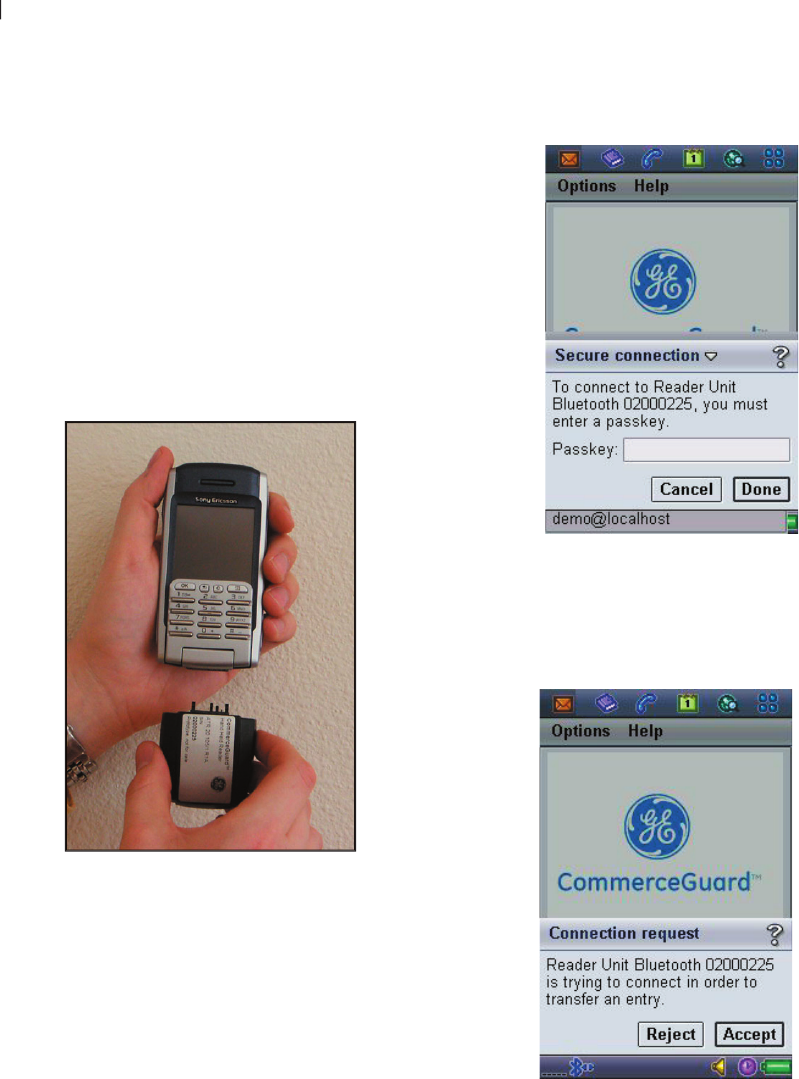
8
Plug In Reader and Verify
Communication
Before the phone can interact with CSDs, you
must connect the Portable Reader Unit to the
phone.
To connect the reader:
Login to the Security Client software.
Attach the Portable Reader Unit to the
phone.
1.
2.
Wait until the ‘Secure connection’ dialog
appears, enter your Passkey and tap
Done.
3.
Once the Bluetooth communication is
activated on the cell phone (look for the
Bluetooth icon in the lower left corner) a
‘Connection request’ dialog appears. Tap
4.
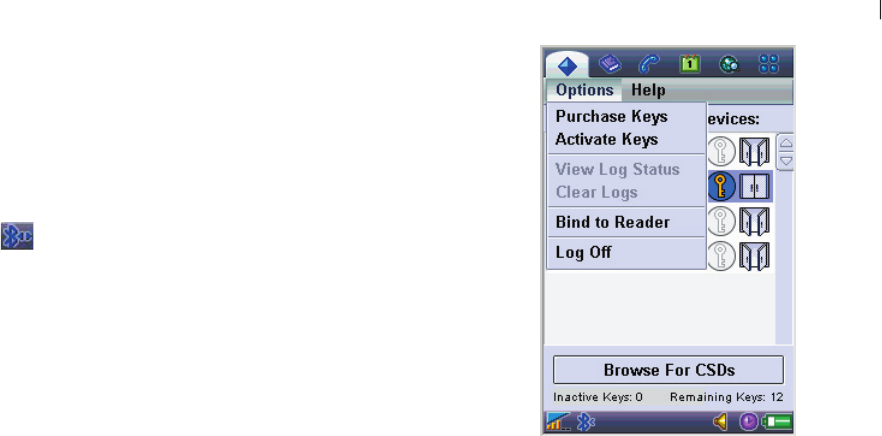
9
CommerceGuard™ Security Client for Symbian
the Accept button and the main window
opens.
Note: If this request appears again, tap
Accept again.
One outgoing arrow on the Bluetooth icon
One outgoing arrow on the Bluetooth icon
indicates that the cell phone is trying to
talk with the reader module. Two arrows (as
shown in icon above) indicate phone/reader
interaction – which is the fi nal OK!
Binding the Reader to the Phone
A handheld reader can be bound to a phone
to bypass the “Secure connection’ and
‘Connection request’ dialog boxes each time
the reader is attached to the phone.
To bind the reader to a phone:
Attach the reader to the phone
Verify communication between the phone
and reader.
Press Browse For CSDs button ten (10)
times.
Select Bind to Reader from the Options
drop-down menu.
Wait at least a few seconds before
performing any functions.
1.
2.
3.
4.
5.
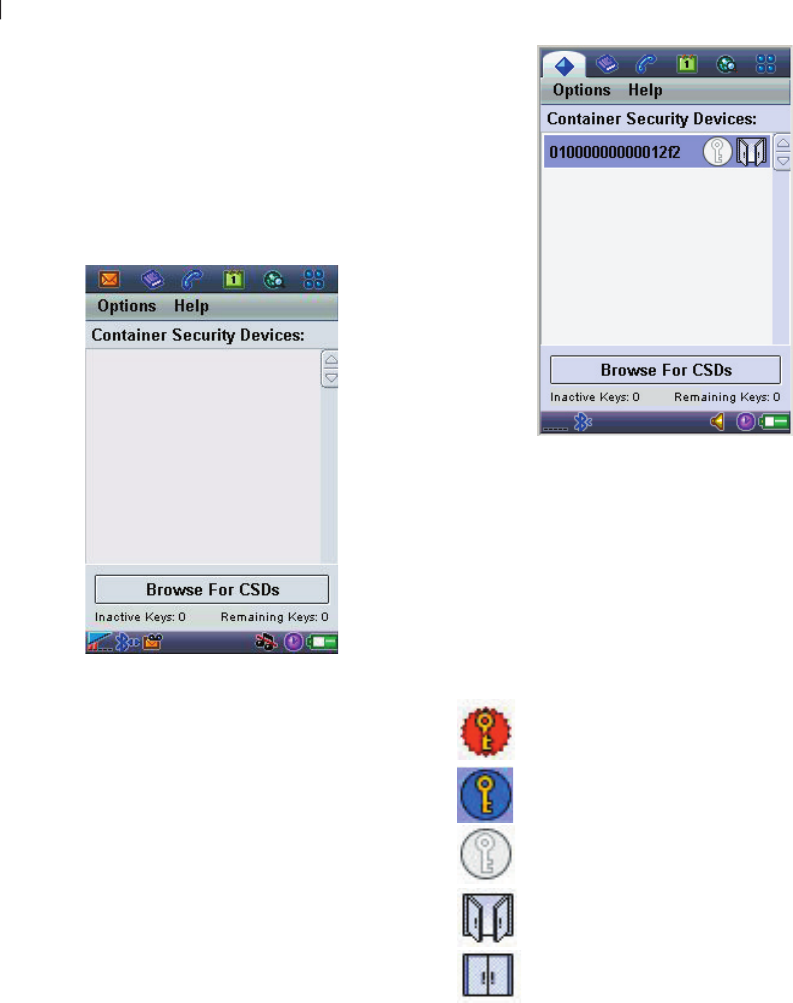
10
Viewing Status of CSDs
With the handheld reader attached the
phone displays the status of all CSDs within
range.
From the main screen tap Browse For CSDs.
The reader automatically checks for active
CSDs within range and lists them in the main
window. This procedure takes a few seconds,
and each time you tap the Browse For CSDs
button the list is refreshed.
Each CSD has a unique ID programmed into
the CSD. The CSD ID number is also located
on the CSD serial number label. CSD IDs are
displayed on screen as the one shown above:
01000000000012f2.
The arming status and door status is
displayed for each CSD.
Container is tampered
Container is armed
Container is disarmed
Container door is open
Container door is closed
The CSD shown above is disarmed and the
container door is open.
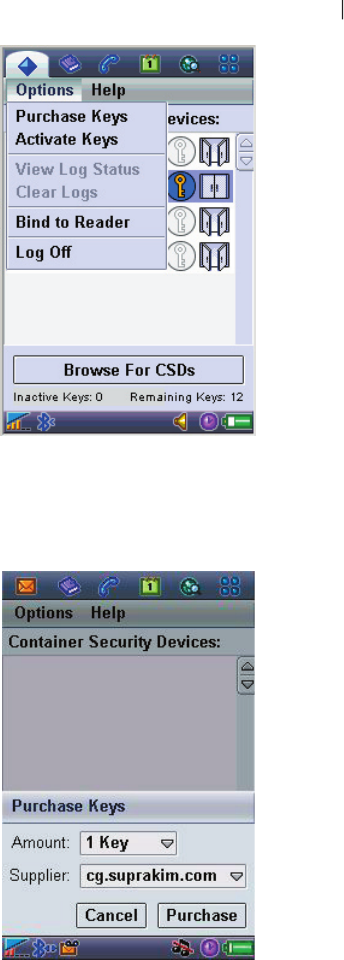
11
CommerceGuard™ Security Client for Symbian
Downloading/Purchasing
Encrypted Keys
An Arming key is required to arm a CSD. Arming
keys are purchased using the Purchase Keys
menu option.
Each time a CSD is armed an arming key is
used. Once a CSD is armed the arming key is
used and cannot be used again.
If there are no arming keys left, the user must
purchase arming keys before arming a CSD.
Arming keys can only be used by the user that
purchased them on the platform where they
were purchased (i.e., a user that purchases
arming keys using the Security Client for
Symbian can’t use the keys on the Security
Client for Windows).
Downloading/Purchasing Keys
There are two (2) ways of downloading keys:
On-line: when the phone has a GPRS
subscription.
Semi-offl ine: when the phone is
connected to a computer with
Internet access via the cradle.
Note: For demonstration (using
demo@localhost), there is no need
to download keys in advance. A
“dummy” key is automatically
generated during the arming
process.
From the main screen select the Options
drop-down menu.
•
•
1.
Select the quantity of Keys from the
amount drop-down menu (1, 10, or 20).
The keys will remain usable for your login
even if you turn off the cell phone.
Tap ‘Purchase’.
3.
4.
Select ‘Purchase Keys’ from the Options
drop-down menu. The Purchase Keys
window opens.
2.
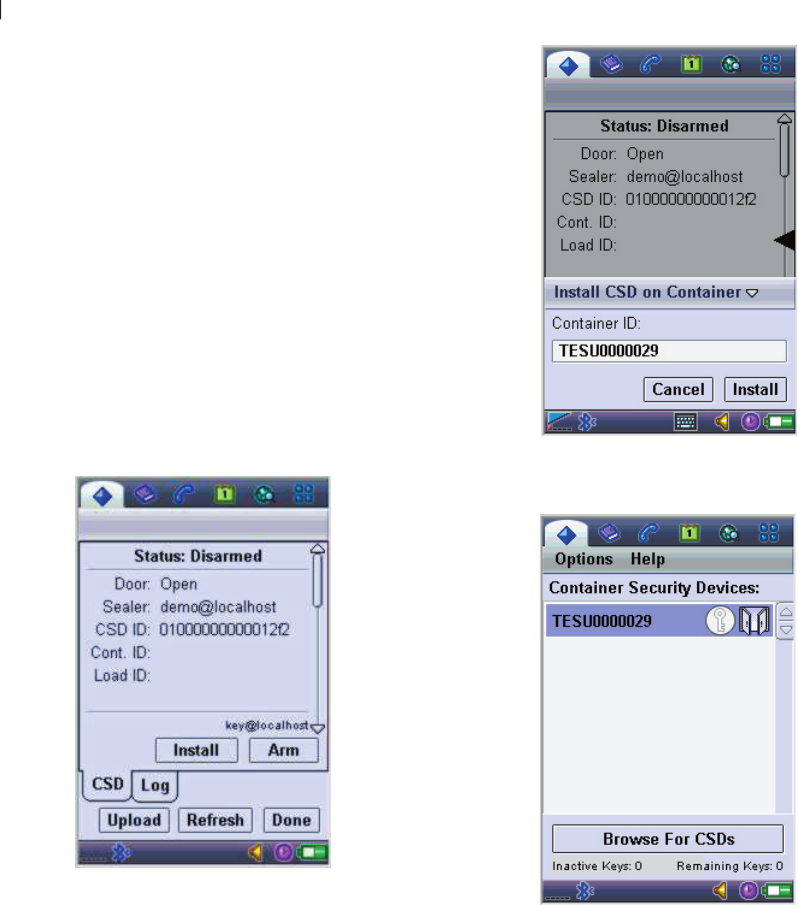
12
Installing the CSD on the
Container
When a CSD is fi rst placed on a container, the
Container ID can be associated with the CSD
using the Install option in the software.
If the Container ID is not entered using
the Install process, it will be required to be
entered during the arming process.
To associate the Container ID with the CSD
once the CSD is in place:
Select the CSD
1.
Tap Install.
2.
Enter the Container ID and click Install.
3.
Once the Container ID is associated with the
CSD it is displayed on the CSD list instead of
the CSD serial number.
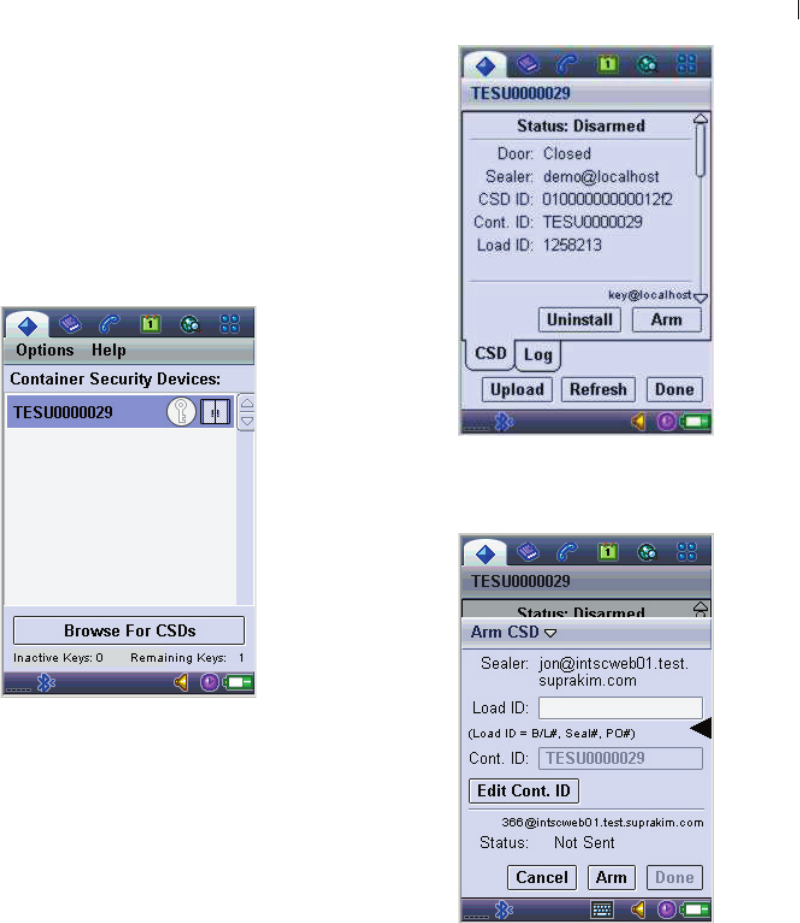
13
CommerceGuard™ Security Client for Symbian
Arming the CSD
Before arming a CSD, verify the container is
stuffed and the doors are closed.
Click Browse For CDSs and check the
symbols associated with the container. This
container indicates the CSD is not armed and
the door is closed.
Verify there are arming keys available by
checking the Key status at the bottom of the
screen. This shows there are no (0) inactivate
CSDs (i.e., armed but not activated), and one
(1) Key remaining, i.e. not consumed. If there
are no Keys remaining, use the Purchase
Keys option from the drop-down menu to
purchase arming keys.
To arm a CSD:
Tap the CSD from the list.
1.
Tap the ‘Arm’ button.
2.
Enter the Load ID.
Enter the Container ID if it was not entered
using the Install option, or click the Edit
Cont ID button to edit the Container ID.
Tap the Arm button.
3.
4.
5.
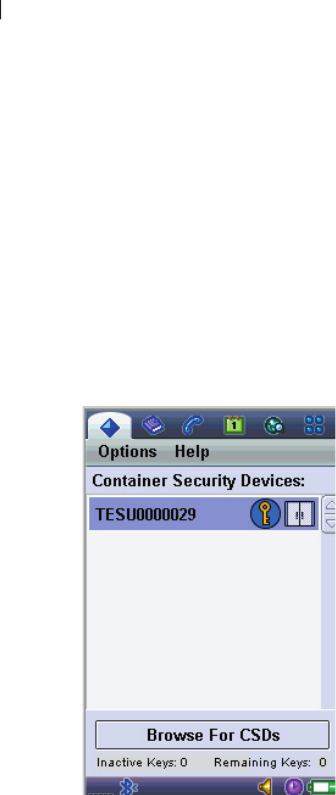
14
Verify that the status indicates Armed.
Tap OK.
Tap done. If the phone has a GPRS
connection, the arming information is
sent to the network and the arming key is
activated.
In the main window tap ‘Browse For
CSDs’ to refresh the list. The arming and
door status icons now indicate that the
container is armed and door is closed.
6.
7.
8.
9.
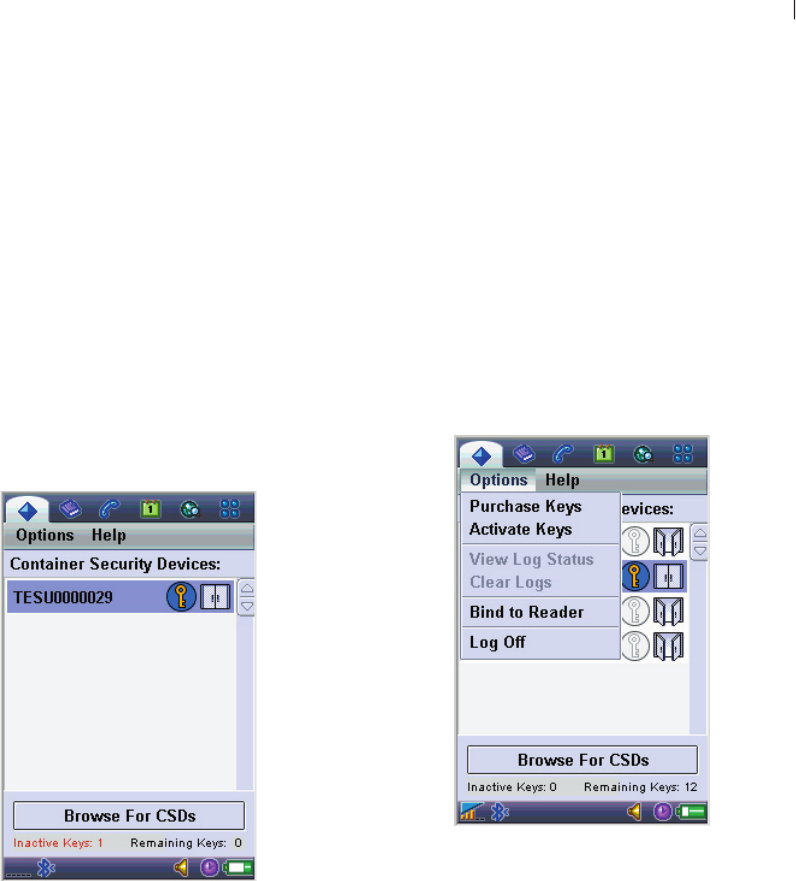
15
CommerceGuard™ Security Client for Symbian
Activating Consumed Keys
After a CSD is armed the arming information
needs to be sent to the CommerceGuard
network. If the phone has a GPRS connection,
the information is sent automatically. If the
phone does not have a GPRS connection or is
interrupted while sending arming information,
the arming information is saved on the phone
so it can be sent later.
If the arming information has not been sent,
the key status in the lower left corner
indicates there is an inactive key. With an
inactive key the CSD is armed but the server
does not know the CSD is armed.
The arming information can be sent up
manually using the Activate Keys menu option
or, the next time a CSD is armed while online,
saved arming information is sent up along with
the new arming event.
There are two (2) ways of activating Keys:
Online: when the phone has a GPRS
subscription.
Semi-offl ine: when the phone is
connected to a computer with
Internet access via the docking
cradle.
To manually activate keys not automatically
sent:
Verify you have GPRS coverage or dock
the phone to the cradle.
Select ‘Activate Keys’ from the Options
drop-down menu.
•
•
1.
2.
Now all armed CSDs are activated
and the arming procedure is
complete.
3.
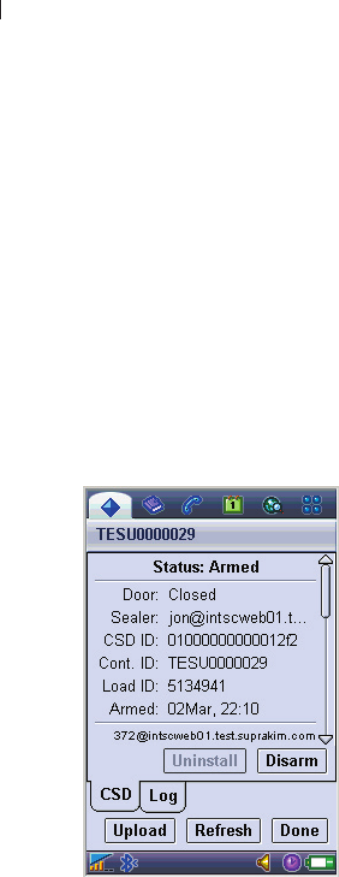
16
Uploading CSD Status
Uploading the status of a CSD requires a
GPRS subscription on the phone. When
uploading a CSD status the CSD arming
information and Container ID is uploaded to
the server with a timestamp. This provides a
way for viewing the CSD status remotely.
To upload a CSD status:
Select Browse For CSDs
Select the Container ID
Tap the Upload button.
1.
2.
3.
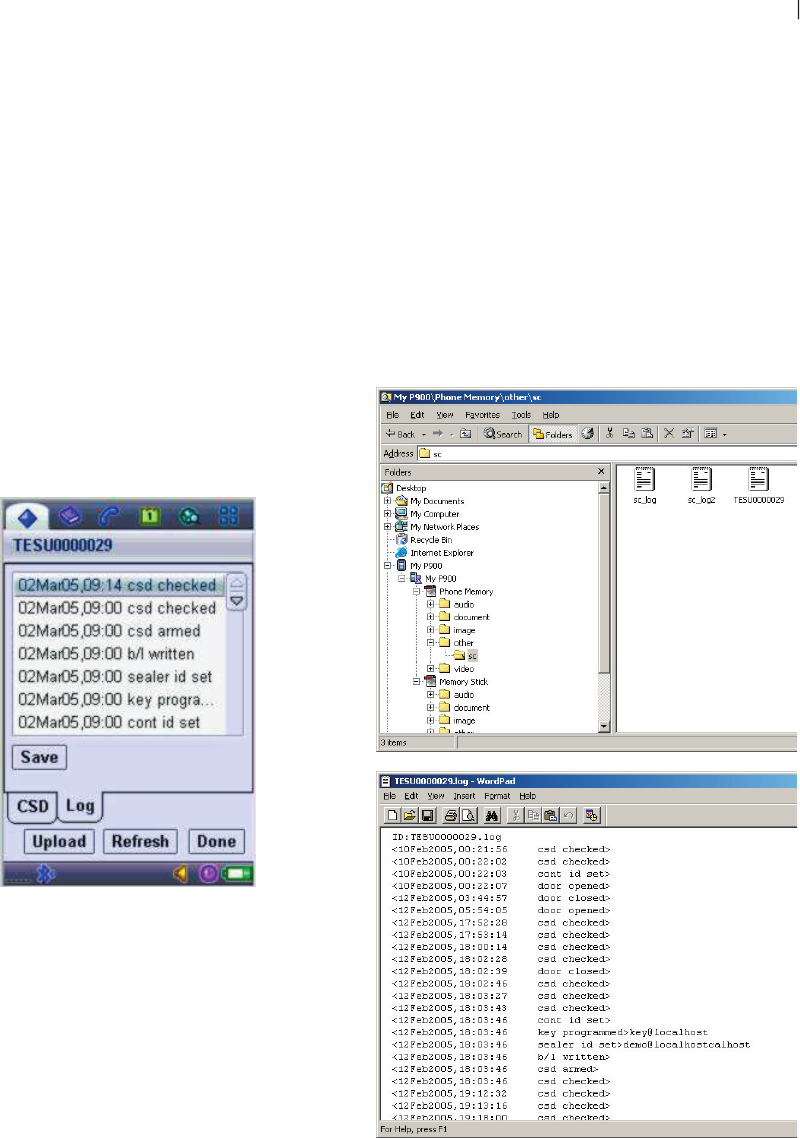
17
CommerceGuard™ Security Client for Symbian
If you would like to save the log fi le, tap the
Save button. The entire log fi le will be saved
to phone memory.
Dock the phone in the cradle to transfer the
log fi le to your computer.
To access the log fi le in Windows Explorer
4.
5.
6.
(PC); dock the phone in the cradle.
Note: The log fi le is named after the
CSD ID or the container ID if one is
assigned.
From Windows Explorer; “Drag and drop”
the fi le onto the Desktop.
Open the fi le in WordPad.
Note: Do not use NotePad.
7.
8.
Checking the CSD Data Log
CSD activity is stored in a data log and can
be viewed and saved on your computer. This
process could come in handy for emailing a
CSD data log.
Tap Browse For CSD to refresh the
container list.
Tap the container ID that you want to
check. You can see who armed the CSD
and when it was armed.
Tap the Log button and then the Refresh
button to view the CSD event history.
1.
2.
3.
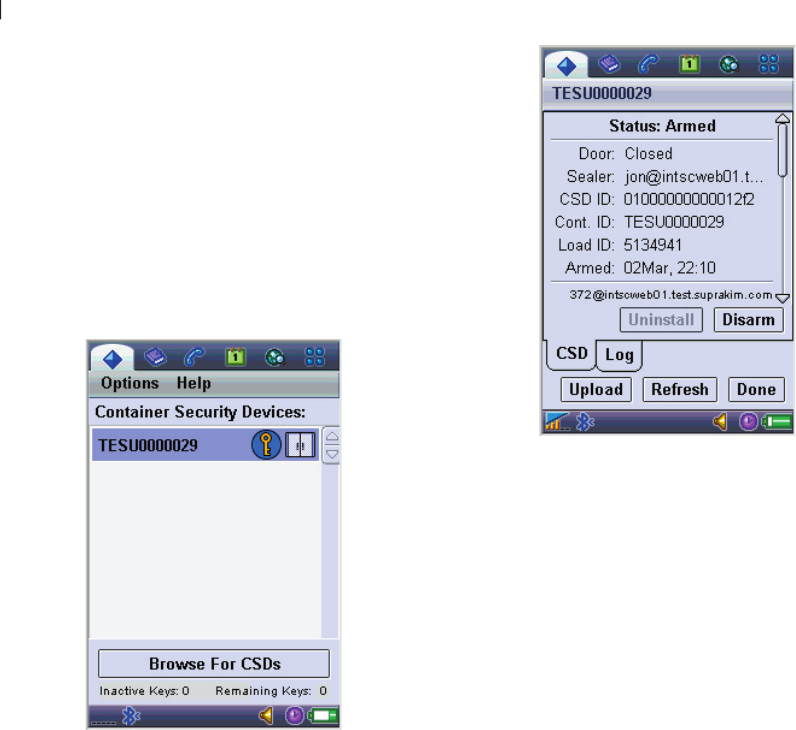
18
Disarming the CSD
When a container with an armed CSD arrives,
it should be disarmed before it is opened.
The disarming information is automatically
uploaded to the server if the phone has a
GPRS subscription.
Tap Browse For CSDs to refresh the
container list.
1.
Verify the door and arming status (armed
and closed).
Select the container ID from list.
The arming information is displayed
including who armed the container, when it
2.
3.
4.
was armed, the CSD number, container ID,
and Load ID.
Tap the Disarm button.
Tap Yes to confi rm disarming the CSD.
The disarming procedure is now complete.
5.
6.
7.
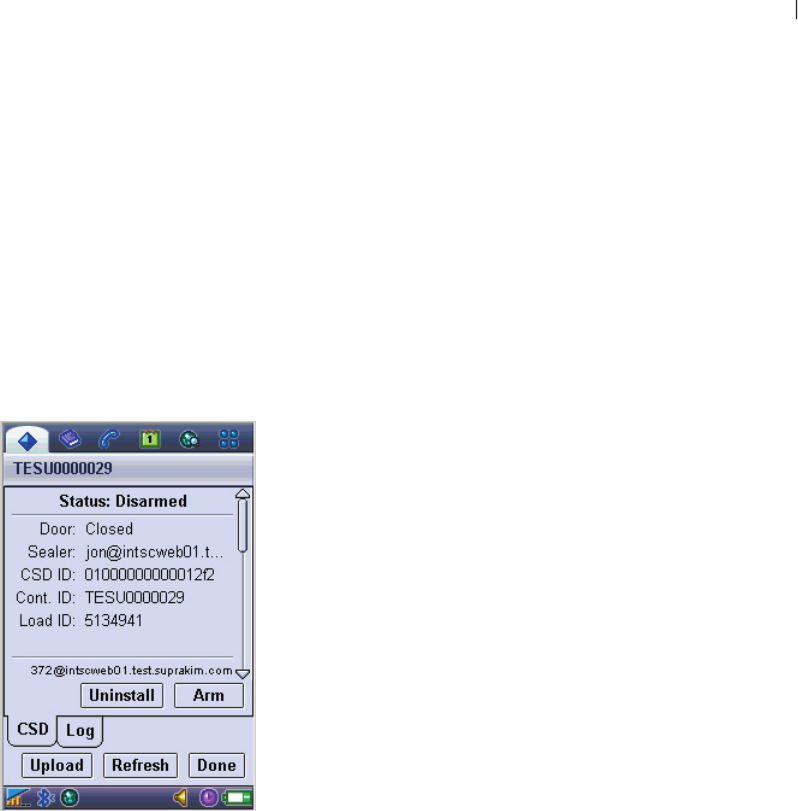
19
CommerceGuard™ Security Client for Symbian
Removing the CSD
The CommerceGuard system is designed
so that once a CSD is placed on a container
it remains on the container. However if you
need to remove a CSD from a container,
use the Uninstall option to disassociate the
Container ID from the CSD.
In the main window; tap Browse For CSDs
to refresh list.
Select the container ID .
1.
2.
Tap the Uninstall button.
Tap the OK button to confi rm uninstalling
the CSD.
Verify that the container ID is replaced by
the CSD ID (i.e., 01000000000000nnn).
Remove the CSD from the container.
3.
4.
5.
6.

20